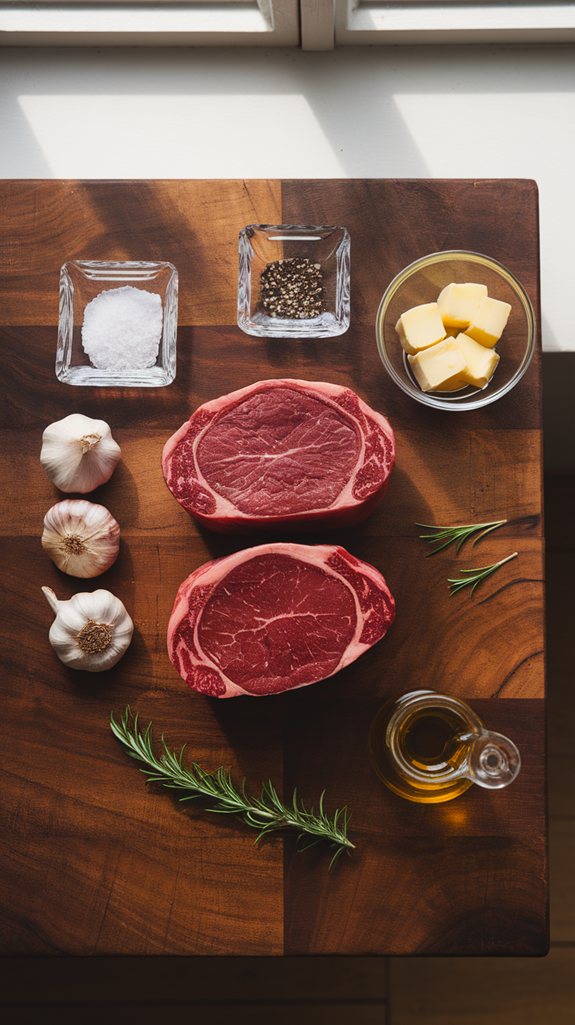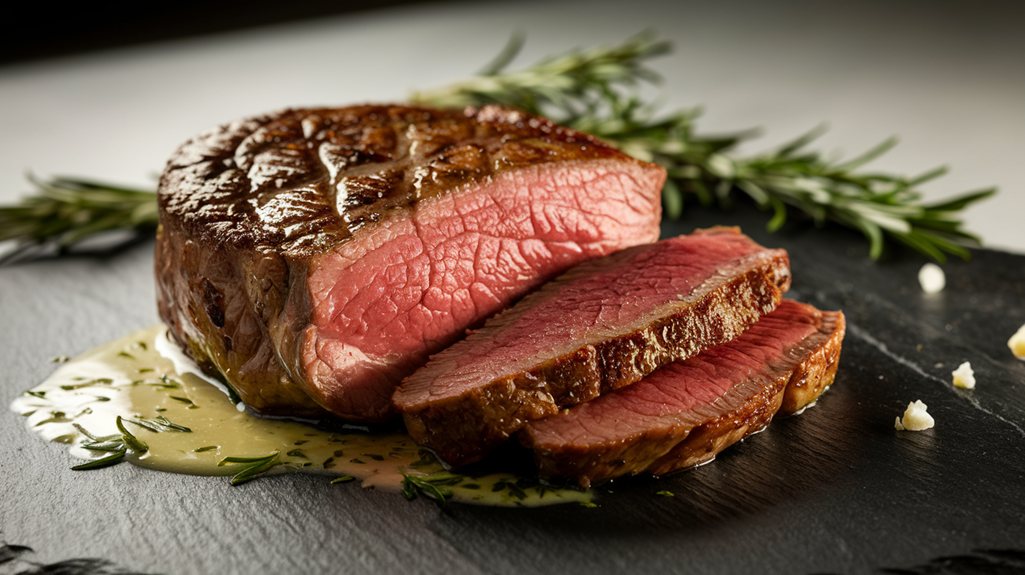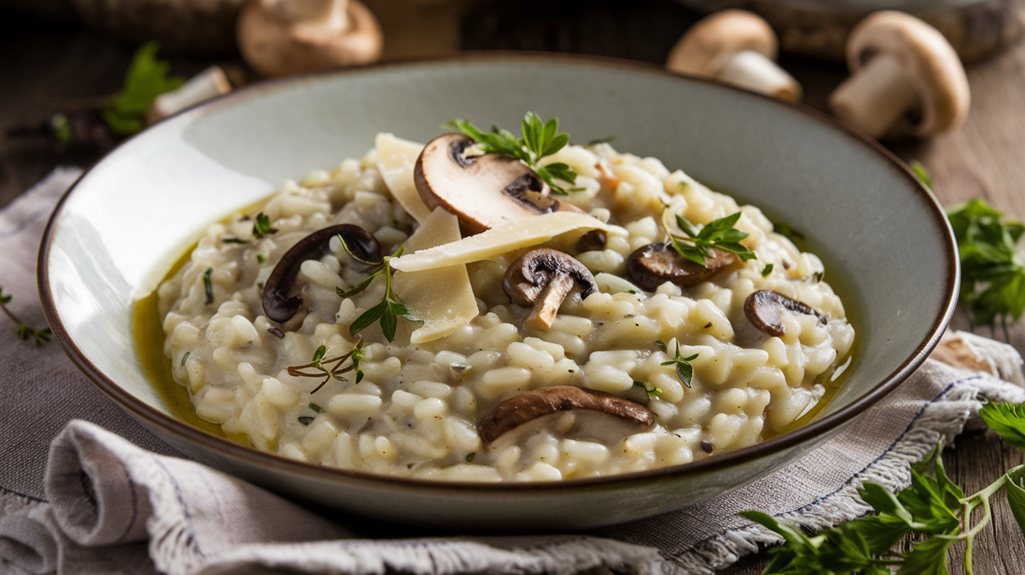Picture yourself at a high-end steakhouse, where a perfectly cooked filet mignon arrives at your table, its exterior caramelized to a rich mahogany while the center remains tender and pink. You'll find that mastering Gordon Ramsay's signature method isn't as challenging as it might seem. With precise temperature control, proper seasoning technique, and careful attention to timing, you can recreate this restaurant-quality masterpiece in your own kitchen – and there's one essential step that most home cooks overlook.
Invented by French Chefs
While the name "filet mignon" translates literally to "dainty fillet" in French, this prized cut of beef was originally raised to culinary fame by French chefs in the early 1900s.
Today, you'll find this tender steak recipe featured in the world's finest restaurants, where chefs continue to honor its French heritage through classic preparation methods.
If you're looking to create impressive gourmet dishes at home, the filet mignon offers you an opportunity to showcase your cooking skills.
French chefs realized that this particular cut, taken from the smaller end of the tenderloin, required minimal seasoning to shine.
They developed techniques like pan-searing and butter basting that you can still use today to create a perfectly cooked steak with a caramelized exterior and buttery-soft center.
The perfect steak should reach medium-rare temperature of 145°F for optimal tenderness and flavor.
Similar to how Pan Seared Scallops develop a rich crust with high heat and butter finish, these techniques create an exceptional result.
Much like Beef Wellington preparation, mastering filet mignon requires precise timing and attention to detail to achieve the perfect result.
Classic Restaurant Dish

Gordon Ramsay's restaurant-style filet mignon represents the pinnacle of steak preparation, combining simple yet precise techniques to achieve a perfectly cooked, tender cut of beef. The method focuses on achieving a golden-brown crust while maintaining a juicy, pink center through careful temperature control and timing. The Tender Titan is prized by chefs worldwide for its exceptionally soft texture and lean profile.
The key to restaurant-quality filet mignon lies in proper preparation and seasoning. Starting with room temperature meat guarantees even cooking, while a cast iron skillet provides the intense heat needed for a proper sear. The addition of butter, garlic, and herbs during the final stages of cooking creates the rich, complex flavors associated with high-end steakhouses.
Like his Michelin-starred restaurants worldwide, this filet mignon recipe showcases Ramsay's dedication to culinary excellence and innovation in the kitchen.
Ingredients:
- 2 filet mignon steaks (6-8 oz each)
- 2 tablespoons neutral cooking oil
- 4 tablespoons butter
- 4 garlic cloves, crushed
- 2 sprigs fresh rosemary
- Sea salt
- Black pepper
To cook the perfect filet mignon, start by seasoning the room-temperature steaks generously with salt and pepper. Heat a cast-iron skillet over high heat until smoking, then add oil. Sear the steaks for 2-3 minutes on each side until golden brown.
Add butter, garlic, and rosemary to the pan, and baste the steaks with the melted butter mixture. Transfer to a preheated 360°F oven and cook for 5-8 minutes for medium-rare. Remove from oven and let rest for 5-10 minutes before serving.
When preparing filet mignon, timing is essential. Use a meat thermometer to achieve your desired doneness, and keep in mind that the temperature will rise 5-10 degrees during resting.
Avoid moving the steaks during the initial sear to develop a proper crust, and don't skip the resting period, as this allows the juices to redistribute throughout the meat, maximizing tenderness and flavor.
Regional Seasoning Blends
Different regions across the globe have developed their own signature spice blends for seasoning filet mignon, building upon the classic salt and pepper foundation.
When you're learning how to cook filet mignon, you'll find French chefs often use a mixture of herbs de Provence, while Italian preparations incorporate oregano and basil.
In the American South, you'll see rich steak dishes improved with paprika and garlic powder blends.
For Gordon Ramsay's filet mignon recipe, you'll want to stick to his preferred mixture of sea salt, cracked black pepper, and fresh thyme.
However, you can experiment with Montreal steak seasoning for a Canadian twist, or try Japanese-inspired togarashi for a subtle heat.
Just remember to apply your chosen blend liberally before searing to create a flavorful crust.
Mastering Pan-to-Oven Transfer
Three key factors make the pan-to-oven transfer a critical moment in cooking the perfect filet mignon. Initially, you'll need an oven-safe skillet, preferably cast iron, that's been properly heated for the initial pan-seared phase.
Subsequently, your timing must be precise – transfer your steak to the 360°F oven right after you've added the butter and aromatics to achieve that tender steak recipe's ideal results.
Finally, you'll want to handle this transition quickly but safely. Once your filet is beautifully seared on both sides, use oven mitts to move the entire skillet into your preheated oven.
This oven-finished technique allows the heat to surround your steak evenly, creating that restaurant-quality medium-rare center while maintaining a perfect crust.
Store Leftovers Sealed Tightly
Proper storage of leftover filet mignon can preserve its quality for up to three days when you follow the right techniques.
For your gourmet steak, let it cool to room temperature for no more than 30 minutes before storing. Wrap each piece tightly in plastic wrap, then place in an airtight container.
When storing multiple pieces of your savory meat dishes, avoid stacking them directly on top of each other. Instead, layer them with wax paper in between.
Keep your filet mignon in the coldest part of your refrigerator, typically the back, at 40°F or below.
When you're ready to enjoy your leftovers, reheat them gently in a pan over medium-low heat to maintain their texture and juiciness.
Rest Before First Cut
After cooking your perfect filet mignon, letting it rest is a crucial step that can't be rushed. Your tenderloin needs 5-10 minutes to redistribute its flavorful juices throughout the meat, ensuring each bite stays moist and tender.
Place the filet on a warm plate and tent it loosely with foil to maintain its temperature without trapping steam.
You'll know your filet mignon has rested properly when the meat feels slightly firmer and the juices have settled. If you cut too soon, those precious juices will escape onto your plate instead of staying in the meat.
When you're ready to serve, cut against the grain with a sharp knife – you'll be rewarded with perfectly juicy, restaurant-quality slices every time.







